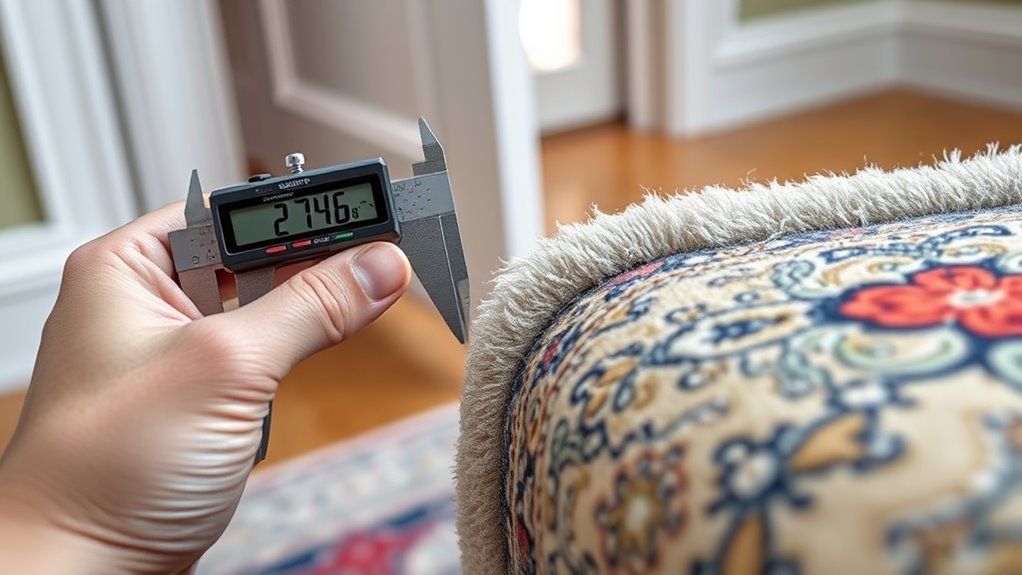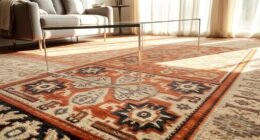To measure rug thickness and identify door clearance issues, you’ll need a measuring tape, caliper, and a flat surface. Lift a corner of the rug and measure the distance between the rug and floor in several spots for accuracy. Check if the door swings freely and measure the gap at the bottom. Adjustments like trimming the rug or adding a thin pad can solve clearance problems. Keep exploring for detailed tips to guarantee your space works perfectly.
Key Takeaways
- Use a ruler or caliper to measure rug thickness at multiple spots for accuracy.
- Check door clearance by measuring the gap between the door bottom and the floor when closed.
- Ensure the rug is placed on a flat surface before measuring to get consistent results.
- Identify if the door drags or hits the rug, indicating clearance issues needing adjustment.
- Consider thinner rug options or adding a rug pad to increase clearance and prevent door problems.
Tools and Materials Needed for Accurate Measurement
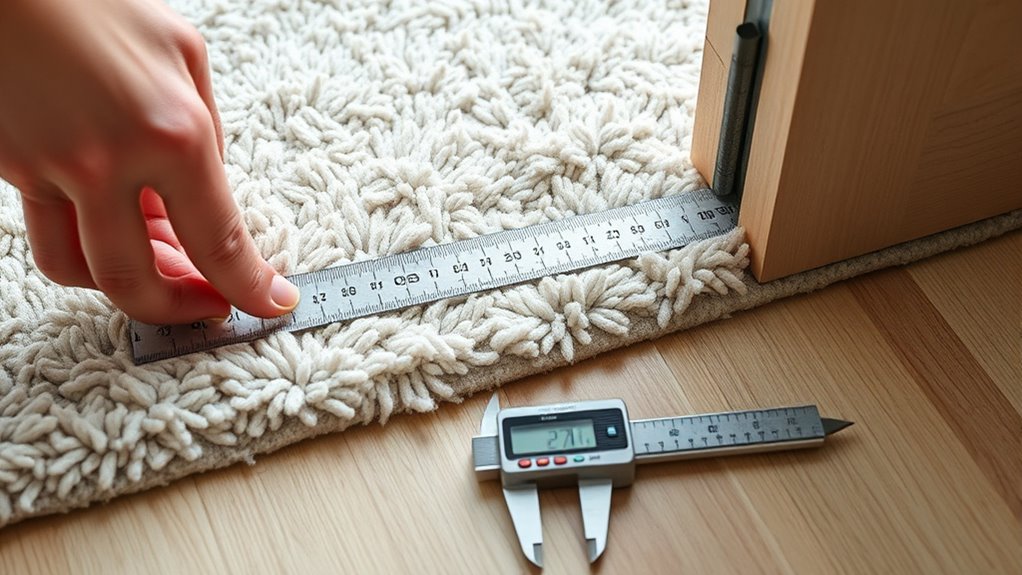
To measure rug thickness and door clearance accurately, you’ll need a few essential tools and materials. First, grab a reliable measuring tape or a ruler to get precise measurements. A digital or manual caliper can be helpful for more detailed thickness readings. Keep a notepad and pen nearby to record your measurements clearly. You might also want a piece of scrap wood or a flat, sturdy object to help gauge the height difference if needed. Confirm your measuring tools are clean and in good condition for accuracy. If you’re using a digital caliper, check the battery beforehand. Having these tools ready before you start will streamline the process and ensure you get accurate, reliable measurements for your rug and door clearance project. Proper measurement techniques are essential for home security systems that depend on precise installation to deter intruders effectively.
Step-by-Step Guide to Measuring Rug Thickness
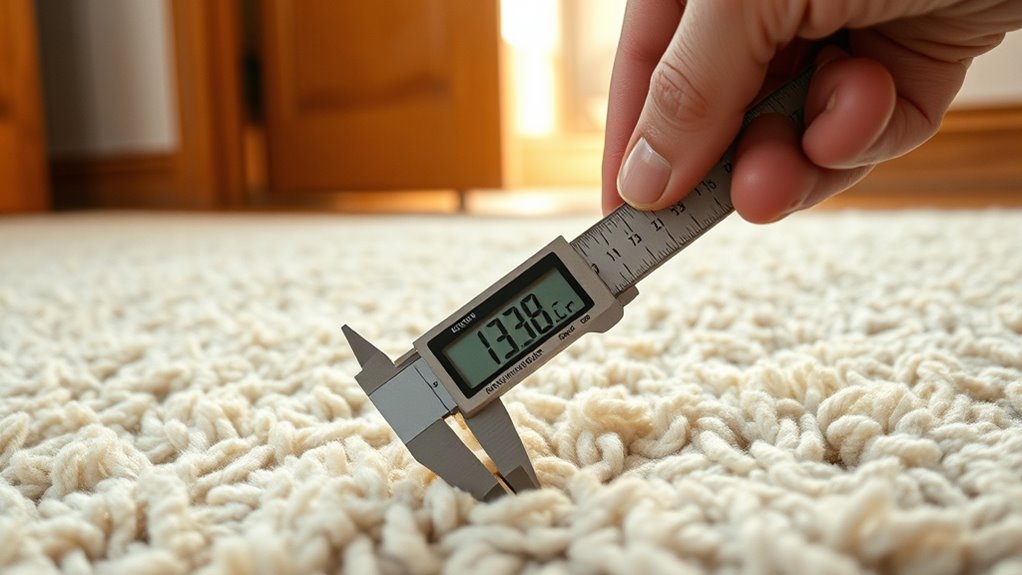
Start by placing the rug on a flat, stable surface to guarantee consistent measurements. Use a ruler or a measuring tape with clear, easy-to-read markings. Gently lift a corner of the rug and position the ruler vertically at the edge, ensuring it’s perpendicular to the surface. Slowly insert the ruler or a thin object, like a piece of cardboard or a credit card, between the rug and the surface underneath. Push down lightly to compress the fibers, then note the measurement where the object contacts the rug’s top surface. Repeat this process at multiple spots across the rug’s surface to get an accurate average thickness. Avoid pressing too hard, which could compress the rug and alter the measurement. Remember that rug thickness can vary across different areas, so measuring several spots provides a more representative reading. Record your results to compare or determine if the rug fits your door clearance needs.
Assessing and Identifying Door Clearance Problems

Once you’ve measured your rug’s thickness, it’s time to see how it interacts with your door clearance. Check if the door swings freely over the rug or if it drags, scraping or catching on the edge. Look for signs of resistance or uneven movement, which indicate clearance issues. Use a ruler or a straight edge to gauge the gap between the bottom of your door and the floor when closed. To visualize common problems, consider this table:
| Issue | Indicator |
|---|---|
| Door drags on rug | Resistance when opening or closing |
| Gap is too small or nonexistent | Door hits the rug, won’t open fully |
| Uneven door swing | Door swings unevenly, catching on rug |
| Excessive gap | Too much space, rug shifts or bunches |
Identifying these signs helps pinpoint clearance problems. Proper measurement techniques can help ensure your door clearance is adequate for your rug.
Solutions to Common Door and Rug Clearance Issues

When you encounter door clearance issues caused by your rug, addressing them quickly can prevent further damage and improve safety. One effective solution is to trim the rug edges with a sharp utility knife or scissors, especially if the rug is slightly larger than needed. Using a rug pad or thin underlay can also lift the rug slightly, making more room for the door to swing freely. If trimming isn’t enough, consider installing door shims or a door sweep to raise the door slightly, providing additional clearance. For permanent fixes, replacing the rug with a thinner option or modifying the door’s bottom edge can be effective. Always measure carefully before making adjustments to ensure smooth operation without compromising safety or aesthetics. Additionally, understanding rug thickness and its impact on clearance can help you choose the best solution for your space.
Tips for Choosing the Right Rug Thickness for Your Space
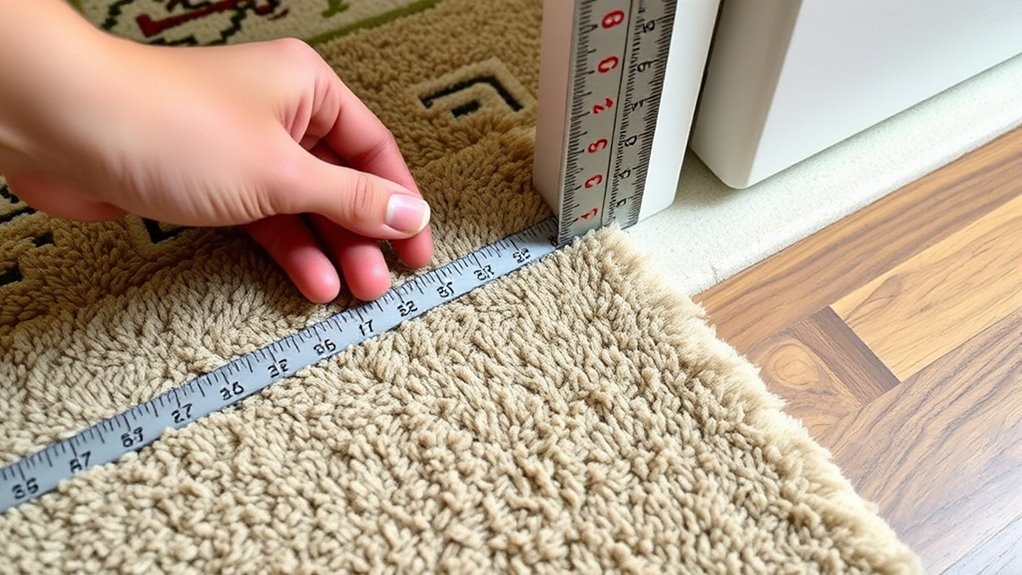
Choosing the right rug thickness depends on your space’s function and style, as well as practical considerations like door clearance and comfort. Thicker rugs add plushness and warmth but may interfere with doors or movement. Thinner rugs work well in high-traffic areas or where door clearance is tight. To help you decide, consider this table:
| Rug Thickness | Ideal For | Considerations |
|---|---|---|
| 1/8 to 1/4 inch | High-traffic areas, entryways | Easy to slide doors over |
| 1/4 to 1/2 inch | Living rooms, bedrooms | Comfort and style |
| 1/2 inch or more | Cozy spaces, under furniture | Potential door clearance issues |
Choose based on your needs, balancing comfort with practicality to find the perfect fit. Additionally, understanding the flooring materials in your room can help determine the best rug thickness for durability and safety.
Frequently Asked Questions
How Often Should I Re-Measure Rug Thickness and Door Clearance?
You should re-measure rug thickness and door clearance whenever you notice changes in your rug, like flattening or wear, or if you plan to move furniture or doors. Regular checks every few months help guarantee proper clearance and prevent issues. If you’re installing a new rug or making home modifications, measure beforehand. Staying attentive to these details keeps your space safe and functional, avoiding accidental damage or tripping hazards.
Can Uneven Flooring Affect Rug Thickness Measurements?
Imagine walking on a bumpy trail—uneven flooring can similarly influence your rug thickness measurements. Yes, uneven floors can make your measurements inaccurate because they cause the rug to sit unevenly or compress differently across surfaces. When measuring, guarantee the floor is as level as possible. Otherwise, you might think your rug is thicker or thinner than it truly is, leading to improper door clearance and potential issues.
Are There Specific Rugs Better Suited for High-Traffic Door Areas?
When choosing rugs for high-traffic door areas, you should look for durable, low-pile options. These rugs resist wear better and don’t interfere with door clearance. Materials like nylon or polypropylene are excellent because they’re sturdy and easy to clean. Avoid thick or plush rugs in these spots, as they can cause tripping hazards and make opening doors difficult. Opt for rugs specifically designed for high traffic to guarantee longevity and safety.
How Does Rug Padding Influence Door Clearance Issues?
They say, “A stitch in time saves nine,” and that’s true for door clearance. Rug padding can crucially impact this, as thicker padding adds height to your rug, potentially blocking doors. To avoid issues, choose low-profile padding that provides cushioning without elevating the rug too much. This ensures your door swings freely while maintaining comfort and style in your space.
What Safety Precautions Should I Take During Measurement?
When you’re measuring, always wear comfortable, non-slip shoes to prevent slipping or falling. Use a sturdy tape measure or ruler to get accurate readings, and keep your hands steady to avoid mistakes. Clear the area of obstacles to prevent tripping. If you’re working near stairs or uneven floors, take extra caution. Make sure there is good lighting so you can see clearly. These steps keep you safe while making precise measurements.
Conclusion
Measuring rug thickness and door clearance might seem small, but it can prevent big headaches. Did you know that over 60% of homeowners face issues with door clearance due to rug thickness? By carefully measuring and choosing the right rug, you can avoid tripping hazards and door damage. Take the time to assess your space, and you’ll enjoy a safer, more functional home. Small steps today guarantee smoother doors and stylish rugs tomorrow.
